Around the corner sits the electric Mustang Mach-E ready to come out from the shadows and take on the EV high king that is Tesla. The highly anticipated Mach-E hit a bit of a delay but is now finally on its way to customers. Spectators are eagerly and impatiently waiting to see the competition that’s bound to unfold between Ford vs Tesla. For months now we’ve seen Tesla Model Y vs Ford Mustang Mach-E showdowns but past the surface level, the two are more similar than many want to believe.
Index |
||
|---|---|---|
|
|
||
Taking the Mustangs name and heritage into the future, the Ford Mustang Mach-E is an electric crossover looking to dethrone Tesla. While in the same vehicle class it holds similar specs, similar design choices, and a similar buying process. The company that began it all seemingly took a few notes from Tesla , the company that changed it all.

On paper there’s no denying the fact that the Tesla Model Y packs a heavier punch than the Ford Mustang Mach-E. However, where the Mach-E lacks in terms of range and performance it makes up with a lower price, when accounting for the $7,500 tax credit.
| Model Y Performance | Model Y Standard Range | Mach-E Select | Mach-E GT |
| $59,990 | $41,990 | $35,395 | $53,000 |
Specs are nice to point at and compare with but with reality set in, the most sold car in America is the Toyota Camry, a car with a 0-60 of 7.3 seconds. Sure, those with the need for speed could favor higher numbers but as a mass market vehicle, these two cars don’t cater to a singular group of individuals.
Range however can be seen differently. While we might heavily stand by the statement of electric car range not being important, it would be ignorant to not acknowledge the mental barrier that the majority of EV skeptics still face. Regardless of infrastructure, whether or not they need the extra range, whether not it will ever even be used, many will prefer having the vehicle that can simply drive further.
With price factored in to counterbalance Tesla’s lead in range and the lack of importance in regards to performance specs in a family sized crossover, we see the two as equal in the spec department.

Sticking with heritage, both the Tesla Model Y and Ford Mustang Mach-E are American cars. Aside from that, the two couldn’t be any further away from one another in terms of strictly looks. The Mach-E features a rough and rowdy muscle car complex while the Model Y looks to garner the attention of minimalists with its modern and sleek curvature. However both still target the same audience of electric crossover customers.
In the U.S, crossovers sit as the leading vehicle segment jam packed with competition scattered throughout each and every status class. These two however separate themselves from the rest by competing in the smaller sub category of electrification, a category that continues to rise year over year. It only makes sense that in this new era of electric vehicles, crossovers continue to stand out. Simply due to its class, the Tesla Model Y is expected to be the best selling vehicle from the company with Elon Musk stating it could potentially outsell all other current Tesla’s combined.
“We expect the demand for Model Y will be maybe 50 percent higher than Model 3, could be even double… As I understand it, the midsize SUV segment worldwide is the most popular type of vehicle, so we’ll probably see a higher volume of Y than 3.” – Elon Musk
With the Mustang Mach-E being labeled as Ford’s flagship electric vehicle, one could assume a similar path for the vehicle. However, until EV’s begin to outsell their ICE counterparts, it could be a while before we see the Mach-E at the top of Ford’s internal leaderboards.
The Mustang Mach-E vs Tesla Model Y both feature unique designs that will cater to many visually with no true benefit outside of personal bias separating the two.
Like most next generation vehicles, both the Mustang Mach-E and Tesla Model Y have a similar tech oriented approach. As we push towards this “do less, have more” entitled future, technology is focused under the limelight. Tesla has proven to the world that over-the-air software updates simply work, and consumers demand it.
With OTA, Tesla has been able to continuously improve their vehicles in terms of performance, range, and even additions. The company is able to take feedback and suggestions from yesterdays customers to keep them content with the brand. Ford is looking to take a similar approach with the Mustang Mach-E being OTA compatible. While only time will tell what the company does with this power, the first major Ford update has already been announced with the addition of hands-free driving coming early next year.
Both companies produce their own software however Tesla stands out as the only one with gaming and video capabilities. While I truly hope no one is justifying a car purchase simply based off Tesla Arcade, it’s a nice feature to have. With EV’s requiring a bit of added travel time, Tesla has found a way to keep you occupied while charging.
Unlike other dated cars roaming the roads, both of these EV’s are fit with interfaces and displays in line with todays standards. Both high definition large screen touch screen displays are used to control the entirety of their respective vehicles giving us a glimpse into the buttonless future.
For years Tesla has held the great advantage known as their Supercharger Network. With it, Tesla owners could travel to just about any destination in the U.S. at ease. Competitors and third party networks have sprung up but none have come close in size to Tesla’s 2,000+ fast charging stations. The company has made electric car charging easy while keeping the cost to charge a Tesla relatively affordable.
With the build up to the Mustang Mach-E’s release, Ford made a statement that has been scrutinized since. The company claimed to hold North America’s largest charging network without actually having any self-made chargers. However, the claim isn’t so farfetched.
Through Ionity, a charging network co-founded by Ford, and other partnerships, the company already has access to over 12,000 charging stations with 35,000 charging points. This puts them ahead of Tesla’s Supercharging network before even wide releasing their first new-age electric car. They also plan to install a minimum of two chargers at each of their dealerships and offer their own self-branded home chargers.
Yes, this is just a conglomerate of third party networks but Ford didn’t just slap their brand on an alliance. Ford’s charging network collaborations allow Mustang Mach-E owners to charge at an abundance of individual networks without complicating much of anything.
While typically you’d have to sign up to each individual network and figure out each individual networks costs and payment methods, Ford has integrated them all into the car itself. Just like a Tesla, you find a charger using the in-car navigation, plug in, and the car is billed. From a consumer standpoint there is no difference between using the Tesla Supercharger network vs the Ford Charging network. The upper hand here has been minimized through collaboration, something Ford has no issue doing.
With what I would presume is flattery in mind, Fords new dealership fast chargers looks suspiciously similar to something I’ve seen before.
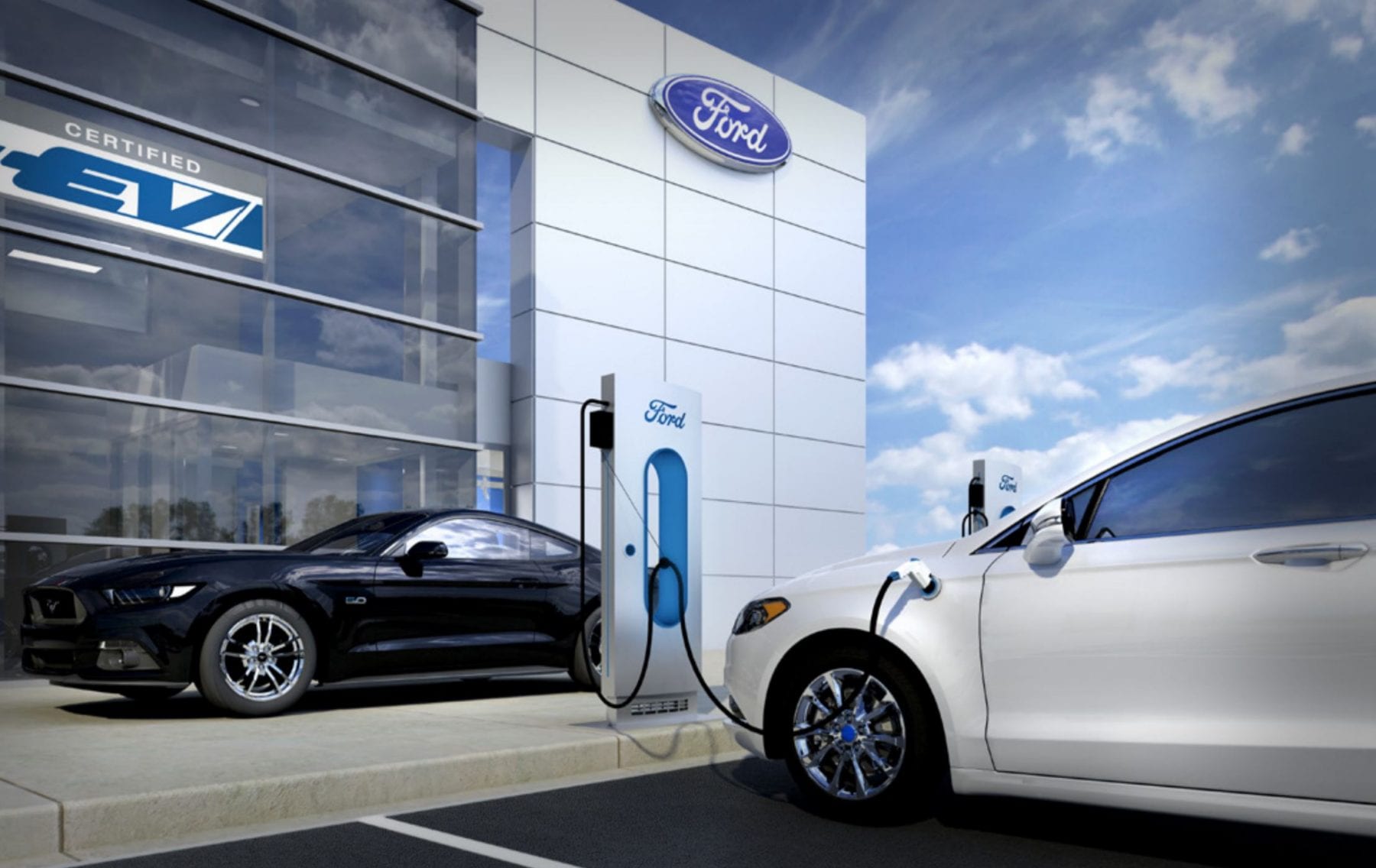
One thing Tesla’s early adopters will continue to argue as being the best in the game is Tesla’s ability to ignore industry standards and pave a new, better, path to purchase. No haggling, no pushy sales staff, no waiting, and minimal physical paperwork. Creating a fully digital approach has forever changed the industry as we know it.
Ford has taken note and created their own online buyers route for the Mustang Mach-E. Arguably more advanced, just like Tesla, Ford customers will be able to make their purchase, pay for their purchase, sign documents, get financing, etc. In addition they’ll be able to add insurance, get trade-in quotes, and opt for home delivery all from a web interface in the comfort of their home, pants not required. Of course Ford still holds the common dealership route for those stuck with tradition, but this new option marks a first for automakers outside of Tesla.
Sadly, Ford’s solution didn’t make the deadline and instead has been delayed until Spring. As we’ll have to wait and see how Ford’s new software holds up, for now Tesla will remain king with their process entirely outdoing the norm.
Through the traditional dealer route, as we’ve tested time and time again, Ford holds major flaws. As an established ICE automaker with a century in the business, converting and training stubborn and misinformed staff has been no easy task. There’s still much to improve in this regard and we truly hope EV sales aren’t lost due to simple mismanagement.
However, Tesla has flaws of its own. Statistically, current EV owners prefer a modern and digital route to the auto buying experience but factually speaking, that amount of people is presently miniscule and consisting of tech savvy internet raised millennials. The average car buyer today is not a tech savvy millennial rather nearing the average age of the acclaimed Boomer era.
Like it or not, Ford’s horrendous process known as the traditional car buying experience is still preferred by the vast majority. As mass produced cars attempting to reach all corners of the market, Ford’s lots could prevail, at least in the short term.
Without a large enough sample size of the Mustang Mach-E, as of now it will remain unknown which vehicle is superiors in terms of build quality.
While Tesla may lead the industry in technology, as a relatively new automaker there’s still plenty of quirks to work out on the production line. Even with the Model Y being Tesla’s 5th rodeo, it still comes with (albeit rare) quality concerns.
According to J.D. Power’s survey of the industry, Tesla falls dead last with 250 vehicle issues per every 100 vehicles. In the other corner, Ford also sits below the industry average with 174 issues every 100 vehicles. While neither vehicle will be known for its finest luxury quality, quality concerns are a leading argument against wanting to purchase a Tesla.
In terms of service, both companies look to innovate in similar ways opting to expand their mobile service tech. Both companies offer close experiences with the only variable left being personal preference.
In this decade you can’t talk about technology without speaking on autonomous driving. The race to robo-taxi’s is at play with every automaker and tech company gunning to be first. With the stated OTA updates, Tesla has been able to continuously improve their autonomous features adding things like red light recognition and other stepping stones towards attaining full self-driving cars. The company claims that every vehicle being built will be capable of driving itself in the future through nothing more than software updates.
The Mustang Mach-E’s approach to autonomy comes at a more basic level. With an above standard adaptive cruise controls and upcoming hands-free driving capabilities, they sit above most but below the EV giant. However, up Ford’s sleeve is a few self-driving projects unrelated to the Mustang Mach-E. With their 40% stake in Argo AI, their own path to fully autonomous vehicles is well in the works.
For the most part Tesla remains very vocal about their self-driving technology with beta testers constantly uploading demos of their full self-driving suit. However, there’s plenty of behind closed door companies working on the very same tech with no public knowledge on where they lie in comparison.
Regardless, the Tesla Model Y sold today is promised to be full self-driving capable through nothing more than software improvements. Ford simply does not make such a claim so if you see a future filled with self-driving cars and believe Tesla will achieve what they claim can be, the Tesla Model Y is a future proof EV.
The Ford Mustang Mach-E is set to be equipped with a Tesla Autopilot competitor via OTA later this year. Whether or not its execution looks as good as it sounds will be left up for future debate.
Earlier this year, Autolist took the Ford Mustang Mach-E vs Tesla Model Y comparisons to the real world. They conducted a publicly held survey to see which direction consumers leaned. The results were a bit interesting.
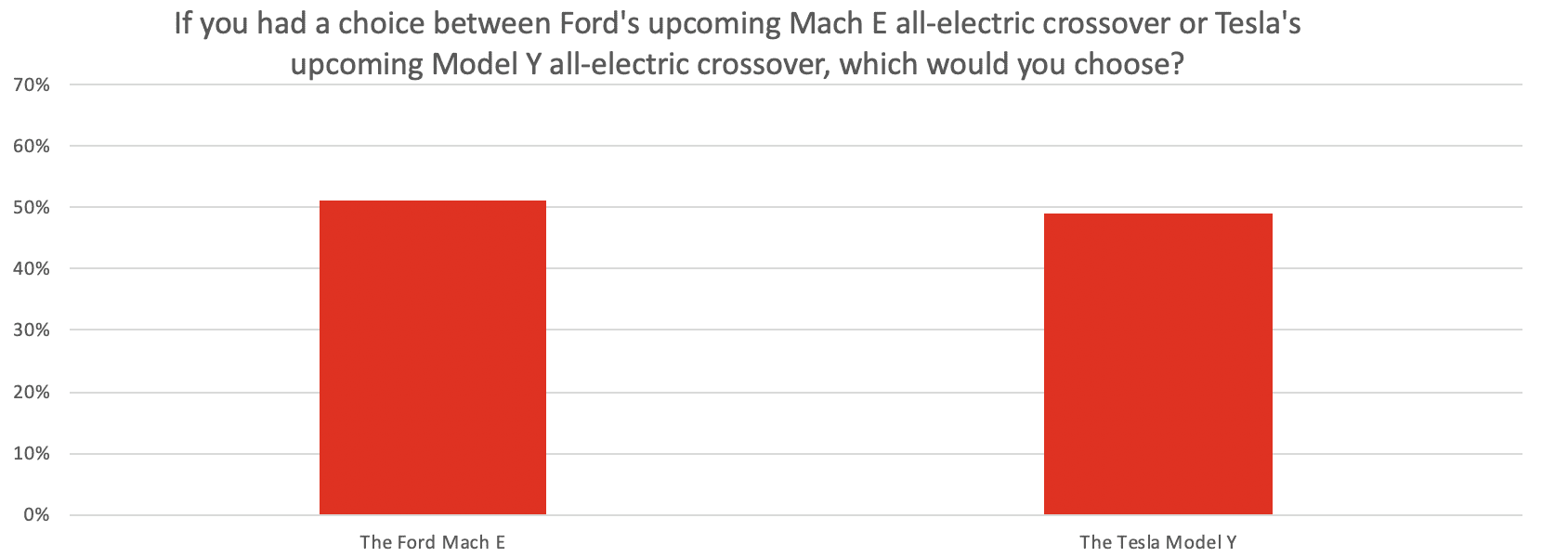
via AutoList
Those surveyed were just about evenly split between the two vehicles. With 51% preferring the Ford, the Mustang Mach E seems to have won the hearts of many. according to AutoList, reasoning for preferring the Ford came down to having more trust in the brand, its vast network of dealerships, and its expected reliability. Those in favor of the Mach-E also simply liked the design choices better and were uncertain of Tesla’s future.
Meanwhile on the other side, the Tesla fans opposed with nearly the exact same. They were disliking and distrusting the Ford brand and reliability. Listing the Model Y’s benefits they stated trust in the company and the vehicles reliability and performance. Tesla’s proprietary Supercharging network allowing you to travel just about anywhere at ease was also listed as a major pro.
Clearly fans of both sides are in disagreement and equally misinformed of one another. Tesla certainly has built a massive name for themselves but Ford has decades of brand loyalty with the Mustang badge. Only time will tell how and if opinions regarding the Mach-E vs Model Y change.
Getting the obvious out of the way, both vehicles sit at the top of their class in the electric crossover segment. Nearing a $800 billion enterprise value, Tesla is over five times the size of Ford, a company once known for its lead in the global automobile market. Tesla broke EV records last year with 499,550 vehicles delivered, Ford on the other hand sold over 3 million ICE vehicles.
Tesla
At face value, the disproportionate numbers could lead to skepticism. However, there’s a few more variables to account for. Without a dealer network, Tesla sells their vehicles direct to consumers, skipping the middle man. This leads to industry leading margins and unrelated, an overall better experience. Tesla is seen by many as the future of automobiles with expectations surpassing 20 million cars a year by 2030.
Through full self-driving and their lead in battery technology, Tesla is also valued off of their future tech potential. The company also holds other revenue sources such as their solar panel business and the massive Supercharger Network. With the addition of self-driving robo-taxi’s, some say Tesla could become the most valuable company in the world.
Ford
While Ford hasn’t changed much in the last century, they see that the path Tesla has laid will lead to a lucrative future. Now, they’re gunning straight for the electric car company with claims that they can do it both bigger and better. As they say, change or die.
Ford is looking at Tesla closer than most. While other manufacturers are simply focused on bringing an EV to market, Ford is changing their entire business model. Through their new e-invoice system, the company seeks to bring a direct sales-esque experience through their dealer network. Tesla has forever changed the future of car dealerships with Ford being one of the first to take notes. The company also looks to immerse the Mustang Mach-E in a fully digital buying experience, as seen with Tesla.
Like Tesla, Ford introduced the Mustang Mach-E alongside a reservation list. In order to be first in line, you must have place a $500 deposit. Unexpectedly, the Mustang Mach-E sold out for it’s first production year.
With their advanced vehicles, Tesla hit a new audience of tech savvy car enthusiasts. However, selling cars strictly online drastically limits their potential customer base. While it’s seen as a major pro to many, the traditional car buyer is decades behind. For this reason, Tesla opted to keep their stores open. In general, people like to touch and feel before they buy.
We all hate the traditional dealership experience but the vast majority of consumers refuse to buy cars elsewhere. A large portion of car purchases are done on a whim which is near impossible to do with Tesla, a company with a constant waiting list. You can walk into any Ford dealership and walk out with a brand new car in just a few hours. As inventory stocks up, this will be one of Ford’s greatest advantages in the race against Tesla. Dealers have surely created a bad name for themselves but their structure and inventory keeps the entire system afloat.
Ford understands this well. After delivering their first batch of vehicles, the company plans to suit every dealership with at least one Mustang Mach-E solely to be used for test drives. Their current ~50,000 preorders will drastically increase as the vehicle is seen and tried by traditional car buyers. Ford already gets significantly more foot traffic and nearly equal online traffic as Tesla currently does.
While Tesla has had to convert consumers to EV’s through means of word of mouth, Ford will do so through their extensive dealer network. With thousands of uninformed car buyers rushing into their stores daily, ready to buy another ICE, Ford’s sales staff will be able to inform and convert car buyers to electric. As Tesla needs to increase their market share to grow, Ford simply needs to sell the Mach-E over one of their other cars to catch up.
Ford’s Future
Due to battery constraints, production for the new electric Mustang Mach-E is capped at 50,000 for the first year. This pales in comparison to Tesla’s one million cars already produced of which over 100,000 alone was just Model Y’s in its first production year.
An F-150 electric truck is set to make an appearance within the next year and will go head to head with the Tesla Cybertruck. An electric commercial van known as the E-Transit is also set to make an appearance soon after. Through Fords partnership with Rivian, plans to build an electric SUV through Lincoln was made. Sadly, these plans were later canceled. We do however hope to see Ford eventually take advantage of their stake in Rivian.
Ford has previously stated their intentions of eventually distinguishing Lincoln as an electric car company. Another electric Lincoln based off the Mustang Mach-E hit the rumor mill last year. Clearly plans are in the works and a transition towards a sustainable company with an EV focus is being made.
Once Ford overcomes battery constraints, which they’ll have to do in order to meet their stated goals of shifting towards an electric lineup, they’ll be able to sell millions of EV’s annually. The true question is whether or not Ford can make the transition and outsell Tesla before they grow too large to catch.
Tesla’s Future
Just a few years ago Tesla lead the industry in just about every aspect. Times are quickly changing as others are catching up with the consumer needs Tesla satisfied years ago. Decent range, a great interface, OTA software updates, and “Autopilot” systems are all achievable by Ford today. The Mustang Mach-E is the first Ford set to have all of it.
The Mach-E wont offer a full self-driving system, as of yet, but it will however offer their proprietary Ford Co-Pilot360 Assist 2.0, a new system which is said to compare nicely to today’s Tesla Autopilot. Like Tesla, the software will continuously adapt and advance itself through OTA updates as well as introduce new features. In a Q&A with a Mach E engineer, it was said that the vehicle will offer a future-proof industry leading interface.
However Tesla still holds a significant lead in range and efficiency. Fast charging on the Mach-E is also limited to 150 kW while the Model Y can hit a max rate of 250 kW. This could factor into some peoples decisions but as long as you don’t drive hundreds of miles per day, most EV owners will never use a public charger.
Tesla continues to grow exponentially with multiple factories currently in development. The Cybertruck is set to begin deliveries by the end of this year with an upcoming more affordable $25,000 Tesla soon to be unveiled. The company has entered the Asian markets, European markets, and now looks to launch in the Indian market.
Tesla’s lead and reach in the EV market cannot be understated. Their battery and even new production technologies exceeds anything Ford has to offer today yet the Mach-E vs Model Y comparison comes close. As vehicles, outside of their surrounding company, the two are pretty equal and both expected to sell extremely well.
EV sales are bound to grow exponentially in the next few years. The Mustang Mach-E alongside other electric cars available to view, touch, and drive will only fix common misconceptions and increase EV awareness. Ford could end up unintentionally selling more Tesla’s than Mach-E’s on their lots simply through fixing misinformation around EV’s.
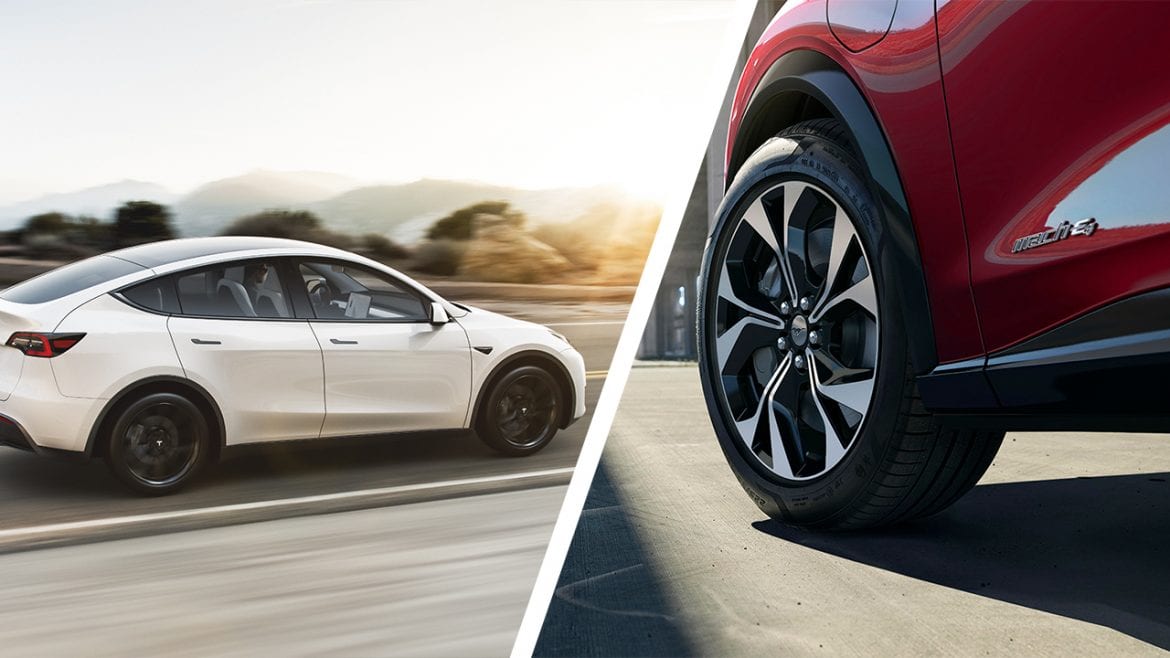

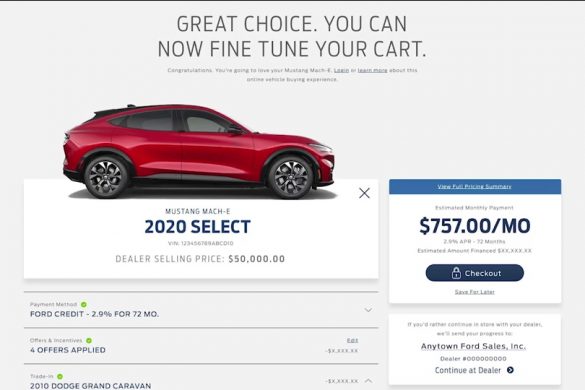

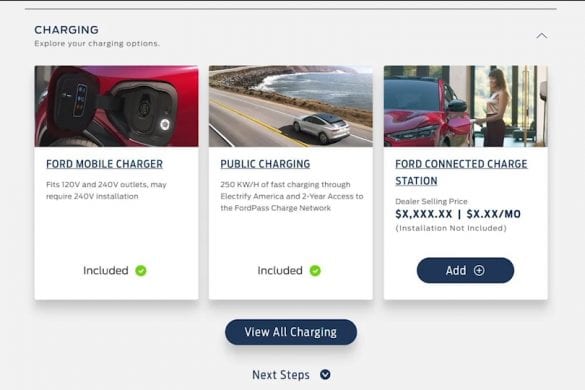
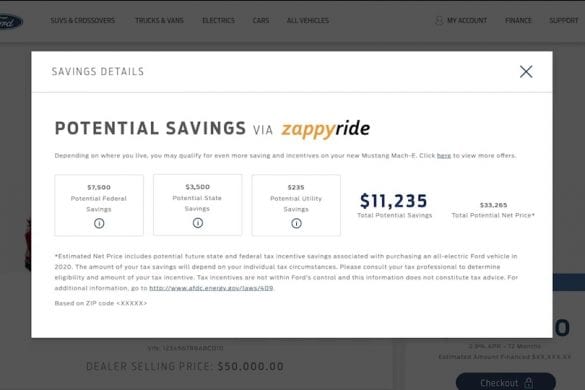



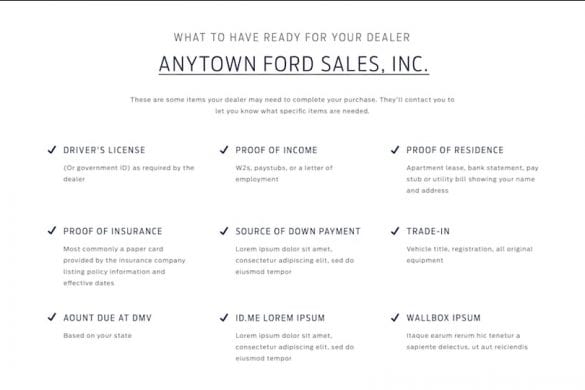
4 comments
What is this 7500$ Incentive that Ford has but not Tesla ?
The first 200,000 EV’s sold by each manufacturer qualifies for a $7,500 tax credit in the U.S.
Qualifying Cars
You got the prices all wrong distorting the results unfairly in favor of Tesla. First, you quote them along with the “Lifetime Savings”. For example, the Long Range Model Y costs $49,990 not $45,690 as you cite above. Second, you include the $1,100 delivery charge on the Mach-E but not the $1,200 delivery charge for the Tesla.
Those prices do not include Fords delivery fee. However, you did spot an error with the LR Model Y.